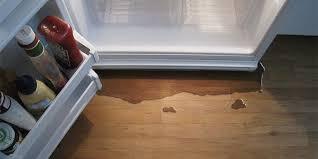In a world where energy efficiency is increasingly important, it’s easy to overlook the small, silent ways our appliances might be costing us more than we realize. Take, for instance, the humble refrigerator—a workhorse in every home and commercial kitchen. It hums along quietly, keeping perishables fresh, frozen foods frozen, and drinks perfectly chilled.
But what if one simple component—barely visible—was allowing cold air to leak out day after day?
Welcome to the world of refrigerator door leaks. Often caused by worn-out gaskets or minor door alignment issues, these seemingly small flaws can lead to significant energy loss, appliance wear, and even health risks. Let’s break down the real cost of a bad seal—and more importantly, how to fix it.
The Hidden Leaks That Drain Your Wallet
Your refrigerator runs by maintaining a consistent internal temperature, typically between 35°F and 38°F. To do this, it relies on insulation, internal sensors, a functioning compressor, and a tight door seal. The seal—provided by the refrigerator gasket—creates an airtight closure every time the door is shut.
When that gasket is no longer doing its job properly, a few things happen:
- Cold air begins to escape.
- Warm air enters the fridge and condenses into moisture.
- The compressor kicks on more often to regulate the temperature.
- Your energy bill begins to creep upward.
Most homeowners don’t notice the change right away. It’s not like the door flies open or the food immediately spoils. Instead, it’s a slow bleed—an extra five minutes of runtime per hour, 20 more kilowatt-hours per month, and eventually, hundreds of dollars lost each year.
Spoiled Food and Health Hazards
Beyond the energy cost, there’s a more immediate concern: food safety.
Refrigerators that can’t stay consistently cold allow bacteria like Salmonella and Listeria to flourish. Dairy products, meats, and prepared foods become breeding grounds if stored above safe temperatures—even for short periods.
A compromised refrigerator gasket can lead to:
- Spoiled groceries, especially in corner areas where air circulation is weakest
- Cross-contamination from drips or leaks
- Mold growth near the edges of the seal
These issues aren’t just inconvenient—they’re potentially dangerous. And they often happen silently, without any clear warning.
The Ice You Didn’t Ask For
If you’ve noticed an unexplained buildup of frost inside your freezer or along the edges of your refrigerator, that’s another red flag. When warm, humid air leaks into the appliance due to a failing gasket, it meets cold air and condenses as frost or ice.
This frost doesn’t just take up space—it can block vents, reduce airflow, and force your appliance to work harder. In extreme cases, it can even cause internal sensors to malfunction or lead to icing over of the evaporator coils.
This cycle often triggers more frequent refrigerator door repair calls, all of which could have been prevented with timely inspection of the gasket.
Signs It’s Time to Inspect Your Seal
Fortunately, gaskets are relatively easy to monitor once you know what to look for. You don’t need tools or special training—just a bit of observation.
Here are a few indicators that your gasket may be compromised:
- You feel cool air escaping around the edges of the door.
- The door doesn’t stay closed unless pushed firmly.
- The gasket has visible cracks, frays, or mold buildup.
- A dollar bill inserted between the door and the frame slides out easily.
- Condensation forms around the door during humid days.
Even if just one section of the gasket is loose or damaged, the entire seal becomes ineffective. That’s why regular inspection is one of the smartest things a refrigerator owner can do.
The Role of Proper Refrigerator Door Repair
While it’s easy to assume the gasket is the sole culprit, other door components may also be contributing to the problem. Over time, refrigerator doors can sag due to worn hinges, especially on full-size models. Misalignment means even a new gasket won’t seal evenly.
Effective refrigerator door repair involves:
- Realigning door hinges for proper weight distribution
- Tightening or replacing door cams that control closure strength
- Replacing door magnets if they’ve lost power
- Ensuring the frame is clean and straight
This holistic approach ensures the gasket isn’t working against a poorly aligned system. In many cases, homeowners replace the gasket only to find the problem persists—because the frame never closed properly in the first place.
The Cost of Delay
Waiting to fix a gasket problem is a little like ignoring a leaky faucet. It might seem minor, but over time it adds up in ways that impact your budget and your appliance’s lifespan.
Here’s what you risk by ignoring a failing gasket:
- Up to 25% higher energy use per month
- Faster compressor burnout from increased cycling
- Shortened lifespan of the refrigerator (which can cost thousands to replace)
- Regular food waste due to fluctuating temperatures
- Health risks from bacteria and spoiled products
Fixing a gasket is simple. Letting it go is expensive.
Prevention Is the Best Maintenance
Just like rotating tires or changing air filters, gasket inspection should be part of a seasonal maintenance routine. You don’t have to do it every week—but checking for wear every few months can save you money and stress down the line.
Quick tips for prevention:
- Wipe the gasket clean every two weeks with a damp cloth.
- Avoid overpacking the door, which stresses the seal.
- Watch for signs of sagging or uneven closure.
- If the seal feels hard or brittle, it’s time for replacement.
When It’s Time to Call the Pros
Some homeowners are comfortable with DIY gasket replacement, especially if they have a compatible model and the right tools. But in commercial settings—or with high-end refrigerators—it’s often smarter to rely on specialists.
Brands like Reliable Gaskets USA offer access to quality components and expertise. Whether you’re managing food storage in a restaurant or simply want your home fridge to run more efficiently, working with experienced providers ensures you’re getting a durable, effective fix.
Conclusion: Don’t Let Air—and Money—Slip Away
Refrigerators are among the most essential appliances in our lives, and yet their performance depends heavily on the smallest of components. A faulty gasket may not seem like a major concern, but it quietly erodes energy efficiency, compromises food safety, and shortens the life of your appliance.
Whether you perform your own checks or bring in a professional for refrigerator door repair, the solution is simple—and the cost of ignoring it is high.
Make gasket checks part of your maintenance rhythm, and your refrigerator will return the favor with years of reliable, efficient service.






